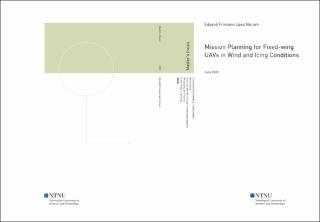| dc.contributor.advisor | Johansen, Tor Arne | |
| dc.contributor.advisor | Hann, Richard | |
| dc.contributor.author | Narum, Edvard Frimann Løes | |
| dc.date.accessioned | 2021-09-23T18:06:27Z | |
| dc.date.available | 2021-09-23T18:06:27Z | |
| dc.date.issued | 2020 | |
| dc.identifier | no.ntnu:inspera:56990118:20897171 | |
| dc.identifier.uri | https://hdl.handle.net/11250/2780922 | |
| dc.description.abstract | Sterk vind og isete forhold er blant de største utfordringene rundt bruk av ubemmanede småfly over lengre distanser. Kjennskap til konkrete værforhold i området der flyvningen skal foregå, gir muligheten til å minimere de uønskede værforholdenes påvirkning på flyet ved å anvende algoritmer for ruteplanlegging og optimalisering. Primærkonfigurasjonen av flyet vil være utrustet med et isbeskyttelsessystem som hindrer is i å danne seg på vingene på bekostning av energi. Hybridelektriske propulsjonssystemer er en måte å drastisk utvide rekkevidden, og dermed sikkerhetsmarginene, til ubemannede småfly på. Dog er hybridelektriske småfly like lett påvirkelige av vanskelige værforhold. Denne avhandlingen vil vise at ved å ta meteorologiske værdata med i betraktningen under ruteplanlegging for slike hybrid-elektriske fartøy kan man nær halvere energiforbruk og tidsforbruk i sammenligning med rett flyvning under konstant marsjfart. | |
| dc.description.abstract | Harsh weather conditions such as wind and icing are a severe curtailment to the operations of unmanned aerial vehicles in terms of performance and reliability. Knowledge of concrete atmospheric parameters in the area surrounding a mission can open many options in terms of how to best traverse said environment. The advent of hybrid electric propulsion systems in such vehicles significantly alter operational range and subsequently the versatility of the platform, but hybrid electric vehicles are equally vulnerable to difficult atmospheric conditions. This dissertation will show that taking meteorological data into account when performing path planning optimisation on such a platform can lead to improvements of up to 50% in terms of both energy efficiency and time efficiency, when compared to a standard, straight cruising flight. Presented here is a model of a hybrid electric, unmanned aerial vehicle equipped with an icing protection system, intended to be employed in wintertime conditions, and a waypoint guidance algorithm realised through particle swarm optimisation. | |
| dc.language | | |
| dc.publisher | NTNU | |
| dc.title | Mission Planning for Fixed-wing UAVs in Wind and Icing Conditions | |
| dc.type | Master thesis | |
